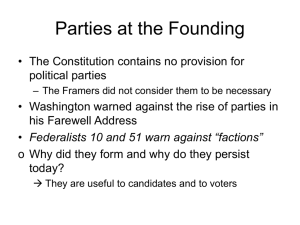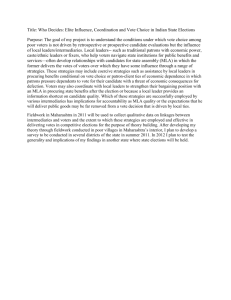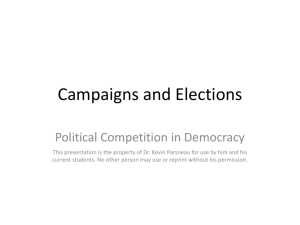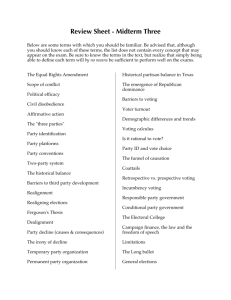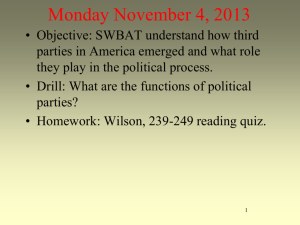File
advertisement
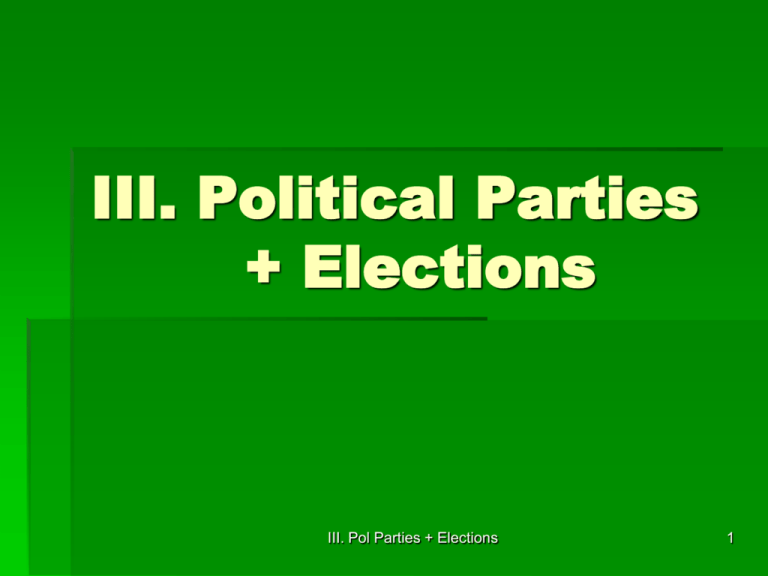
III. Political Parties + Elections III. Pol Parties + Elections 1 A. Purpose of Political Parties 1. A Beacon in the fog of politics - a group of “likeminded individuals” whose purpose is to gain control of gov’t and make policy. 2. Components: 3 headed political GIANT: a. Party in the electorate - voluntary membership b. Party organization - Nat’l, state and local day to day operations whose goal is to select candidates, building platforms, win elections. c. Party in gov’t - elected officials - party or power elites who sometimes agree on policy or the making of policy. 3. Political Ideology III. Pol Parties + Elections 2 4. Party History a. US Parties typically been two-party offering American voters a choice. . .which is what democracy is all about! Historically - Federalists v. anti-federalists evolved into Democrats v. Republicans although . . . III. Pol Parties + Elections 3 b. History of Pol Parties History of Party development 1. Why have Democrats been predominately from the Southern states? 2. Why did the Republican and Democrats split? 3. Why have Democrats, who came from antifederalist roots and state gov’t idealism, now favor Liberal causes? III. Pol Parties + Elections 4 5. . . . 2+ Party system 3rd parties have popped up a. ideological - Socialists, Independents b. Single issue - free soilers, Greenpeace c. Economic protests - greenback party d. splinter - bull Moose III. Pol Parties + Elections 5 5. Republicans and Democrats have switched in dominance since 1800, referred to as re-alignment. Since 1968, era of “Divided gov’t. . .” one party runs the Exec Branch, the other controls Congress . . .which could create legislative gridlock. 6. All parties promotes the same purpose: a. pick Candidates via a nomination b. runs campaigns c. establish an image. . . d. articulate policies e. coordinate policymaking f. compete for votes III. Pol Parties + Elections 6 (1) Down’s Rational Choice theory states . . . (a) voters want certain issues addressed and adopted by gov’t soooooooo (b) parties want to win office byyyyyyyyy selecting policies that are widely favored. . . by the populous. . .nobody votes for losers. . .only for winners! (c) centrist policies usually win. . .don’t drift too far from moderate proposals. III. Pol Parties + Elections 7 7. Is the party beacon getting dimmer. . . a. Many voters have moved to the middle of party identification - a dealignment of party ID. b. 2000 election had over 40% claiming independent monikers. . .w/ Democrats losing more ID than Republicans. c. table 8.1 pg 240. Many people split tickets! III. Pol Parties + Elections 8 Thesis statements Thesis: Define Dealignment. Explain why it has occurred and how it has impacted political party identification. Thesis two: Define Divided Gov’t. Explain how dealignment encourages this type of gov’t by describing how the electorate votes. Thesis 2: Compare and contrast the differences between Dealignment and Realignment. Which one is more apt to lead to Divided Government? III. Pol Parties + Elections 9 B. Party machines – The Hunt for the right candidate? each state manages its own party operation - a decentralized and fragmented system. 1. Patronage dominates - It’s the good boy/girl club. .Party regulars become gov’t appointees IF . . . 2. Finding the right candidates takes parties through “grass roots” democracy, until the inTERparty campaign begins. It seems to last foooooooor evvvvverrrrr to find the right candidates! a. How does one come across a potential party elite? Be a party regular! and hold a public office at some level - US Congressperson or state Guv III. Pol Parties + Elections 10 Intraparty competition begins b. goal- amass enough delegates at the nat’l convention to win the NOMINATION! For your party. All 50 states run their own shows! It starts at . . . . (1). The caucus (12 states use this road) finds delegates for the next level. . . IOWA precinct to county to state to national convention, and also begins platform development. OR (2).Primaries weed out the candidates, not parties. . .you can win w/o party endorsement.. .but it is difficult. GOAL: Get your primary scheduled early? Right Nevada? III. Pol Parties + Elections 11 Types of Primaries. . . . (a) closed - only party faithful can vote (b) Open - You select which camp to vote in (c) Blanket - all parties run on one ballot. - Supreme Court said it was unconstitutional, violated basic function of political party - to choose candidates - Democratic party v. Jones. III. Pol Parties + Elections 12 (d) GOAL- you win the primary, you get the number of delegates the state law allocates. Some are proportional, some winner take all. . . (Super Tuesday in February could end the speculation quickly as state’s front load their primary schedule to gain importance, including Nevada! (e) get the BIG MOo o o o! (f) After all the primaries - tally up your delegates and a majority gives you the nomination. III. Pol Parties + Elections 13 C. Nat’l level - attempting to manage 50 states’operations 1. Nat’l convention - select presidential + VP candidates, sets platform, endorses all party nominees for other offices! Ho Hum 2. National committee 3. national chairperson 4. Campaign highway. Goal: Goal - form enough coalitions ( of SIGS) to win the election INTERparty event (a) dominate the media (b) vanquish your opponent via attack ads! III. Pol Parties + Elections 14 (c) spend lots of money. “money is the mother’s milk of politics” (1) FEC established in 1974 following H20GATE scandal. •gives public financing to candidates. •limits presidential candidates expenditures to $80 million per candidate • requires disclosure of all expenses. • limits candidate’s contributions to $1000 (now $2,300). •soft money allows “party” contributions but McCain + Feingold legislation stopped soft money until 2010’s Supreme Court Case Citizen’s United. . . . •PACs can spend “unlimited amounts” (Buckley v. Valeo) “indirectly” . . . .Power video. • -Voluntary contributions + Super Pacs : III. Pol Parties + Elections 15 The milk spillage . . .$ Who’s Giving Who’s Getting Where 1. Corps/Unions Nonprofits Ads Citizen United 527’s “ Unlimited $$ Super Pacs 2. Individuals Superpacs Ads Unlimited $$ Fed Pacs Candidates $5000 $5000 Natl Parties Ads III. Pol Parties + Elections $2400 Unlimited ? 16 NY Times Ho D. Divided Gov’t 5. Today- many constituents are pulling away from party ID’s -- dealignment- - and this is leading to 1. Many states - 1946-85 had one party control both Gov + Leg; 2001 dropped to 42 percenta) Minnesota had a three way split! b) Voters have become indifferent! --Dealignment Where are voters going. . . 2. Third Parties - What do they represent? Minnesota’s Reform Party is a prime exampleJesse’s Revolution: III. Pol Parties + Elections 17 a). Jesse’s Platform (1) brought left and right wing philosophies. . .pro choice and pro-capital punishment (2) brought out new voter. . .18-26 (3) manipulated the media to his advantage. . .a lot of free publicity (4) Other parties ran half-hearted campaign. (5) don’t need a majority to win. . .need a plurality (SMP) 6) Used Internet shortcut. . .fundraising, deliver the message, avoid the media. III. Pol Parties + Elections 18 b) . Ralph Nader + Ross Perot Nader “stole” Al Gore’s left wing thunder in 2000 election. . .It was that close! and . . . Ross Perot took away of George Bush Sr’s thunder in 1992 when Bill Clinton won. In the ’04 election, was a 3rd party an issue? c). Third parties have an uphill fight. . . (1) Single member plurality voting system (winner take all) system favors two parties. . . and Jesse is only 1 governor of 50 (2) Two Parties have organization. . . Nader was on the ballot in only 43 states. Only seven third party candidates in history have made it on all the states’ ballots. Organizations can raise $$$$ (3) Two parties can moderate views to enhance voters. III. Pol Parties + Elections 19 E. Elections Legitimizing the political process 1. Elections provide for: a. Institutionalizing the political process. All forms of political participation can end here .., Voooooooootingggggggg b. Access to political power w/o violence. . Ballot instead of bullets. The way to choose the right candidates. . . c. Guiding policy direction - either by selecting a new person or by (1) initiatives (Put IT on a ballot) collect the signatures (2) or referendums (vote for it) casting the vote . 2. 2000 Presidential Election was one of a kind. . . Who chose the winner. . .Answer: Popular vote???? Electoral college???? Supreme Court ????. . .the people???? or all of the above! III. Pol Parties + Elections 20 a. A campaign of Gore’s future proposals v. Bush’s attempt to “re-align” country around conservative proposals b. media polls declared it was “too close to call” and it was c. What do we know: (1) Gore won the urban areas. (2) Bush won the burbs III. Pol Parties + Elections 21 (3) Gore won a majority of women and black voters (4) Bush carried male vote decisively. (5) Media would not declare a winner until Florida vote was “legally” recounted because the spread between the two voters was less than 1/10th of one percent. Never in US political history was it ever this close except in Hawaii. Florida has six million voters. . .Bush’s eventual winning spread was less than 1,000 III. Pol Parties + Elections 22 (6.) Florida Supreme Court upheld Gore’s attempt to recount ballots in a way to show the “clear intention of the voter”. (7.) US Supreme Ct ruled in Bush v. Gore that although a recount was legal, the same procedure had to be used in ALL counties, not only those in question. . . . III. Pol Parties + Elections 23 AND there was not enough time to accomplish that mission B4 December 12, when the electoral college was to meet. . .soooooo Bush won Florida w/ 271 electoral votes to Gore’s 269. . . (8) only the 4th time the winner of the popular vote lost an election III. Pol Parties + Elections 24 (9) What did we learn from this process? (a) need to refine the voting process. Many races very close and the machinery designed to count the votes is ooooooold in too many states --- and it is a State problem. (b) Media can’t determine the winners, the voters must. Should Negative ads be allowed? (Living candidate analysis) (c) Third parties can be a major factor in close elections. . .Nader’s Green party garnered 2.7% of the vote and 97,000 in Florida. . .200 times more than the 537 vote margin separating Bush and Gore. III. Pol Parties + Elections 25 (d) Does the electoral college need an overhaul? ((1)) Bush carried the Mountain West and South... Gore the NE and Pacific coast ((2)) Directly voting a winner takes power away from smaller states (at least 12 of them). ((3)) Will 38 states overrule an institution that has been in place for over 200 years? III. Pol Parties + Elections 26 F. ’04 election 1. Polls showed election too close to call but: (a) GW won handily with 286 electoral votes and an overwhelming popular vote. . . Biggest popular vote win since the 1980’s. Maps showed red all over except in California and the NE and. . . Minnesota. (b) Bush also pulled larger wins in House and Senate, which disappeared in ’06 election. Did “re-alignment” occur? III. Pol Parties + Elections 27 G. A bigger issue. . . Suffrage Getting citizens to vote. 1. Suffrage an issue in three constitutional amendments: 15th, 19th, 26th. YOU’RE 18, you can vote. . .but too many don’t. 51% in 2000 election. . .only 30%+ in off year voting. 54% appeared in 04; 56% in ‘08. MN leads in voter turnout. Nevada is on the other end of the list. 2. Who does vote: The Demographics + why a. Old b. high SES c. Educated d. Gender - Females higher e. Married f. union membership III. Pol Parties + Elections 28 3. Who can vote: a. Registration is simple in Minn. . .complicated in other states- ‘93 Motor Voter Act-- driver’s license application check off. It’s complicated in Nevada. b. registration is up but turn-out is down. c. And often parties like it that way. . .because if young, less educated, less well-off people don’t vote. . .power and political elites can remain in power. . . d. e-mail registration and e-mail voting may change the nature of the game as election day becomes election week or another high tech phenom. e. Institutional requirements. . .Citizen, no felons, 18 III. Pol Parties + Elections 29 4. A better issue is “How do voters vote”? a. Party ID. . .although its waning vs. candidate centered elections. Being an incumbent may have more influence than the party in office. Voters don’t seem to mind divided gov’t. “Floating voters” or those so called independents, who vote for the candidate instead of the party beacon, are an issue. Both major parties seek their vote. And a successful campaign can attempt to lure them. 06 voting results b. Candidates’ personna. - What are those leadership qualities: Miller-Wattenberg-Malanchuk: (1) reliability (2) integrity (3) competence III. Pol Parties + Elections 30 I.Voters can dictate policy IF - that IS what a politician does once elected -- make policy- Now will he/she do what they claim? (1) voters know what they want (2) “ “ “ the candidate wants? (3) There are differences between candidates? (4) One casts the vote for your choice When given the option, voters’ policy choices carry IF the candidates positions are clear. . And there are wide policy differences between the candidates. . . . BUTTTT Too often this is not true. III. Pol Parties + Elections 31 (5) Retrospective voting a. Voters CAN support candidates who will provide for them. Ronald Reagan coined it. . . b. “What have you done for me lately?” “Are you better off today than you were yesterday?” If yesssssss . . .vote for me again! b. Obviously major events and economics impact voter preferences. . . III. Pol Parties + Elections 32 (6) A lot of issues. . . (a)Nat’l Youth Service League. (1)At 18 or upon graduation. . .America’s youth will perform two year service to establish one’s civic duty. (a)Military obligation. . .We are at war (b) Civilian duty. . .Schools. . . .inner city . . .Institutional work. . .Parks (CCC) (2) Pay off. . . Intrinsic – Good for America Extrinsic – Civilian GI Bill. III. Pol Parties + Elections 33 H. Why don’t people vote? 1. Institutional obstacles Age, registration, citizenship 2. Apathetic– No political efficacy. No sense of civic duty. 3. Time issues – Too busy . . .costly to give up work . . .It’s a Tuesday 4. Too many elections. . .diffuses enthusiasm 5. No difference between the two parties. 6. Third parties never win so no changes. 7. Vote doesn’t matter, 1 of 100 million! III. Pol Parties + Elections 34 I. Who elects the president? Electoral College? 1. Who are electors? Party wonks. . . Selected by State legislators 2. How “win” electors: Carry states popular plurality vote = unit rule Only Nebraska and Maine goes proportional 3. How many need to win? Need 270, If Tie EC... race goes to . . . the House where each state gets . . . . one vote. Need Majority 4. Big states benefit, especially those w/ big cities. 5. But the EC protects . . . small states! 6. Today issue of swing states. – NV; MO, OH, PA, VA, NC, III. Pol Parties + Elections 35 FL I. Do politicians really understand the voters? 1. If politicians give clear policy options. . .voters can make reliable decisions. . . Retrospective voting “What have you done for me lately? a. economy is a major factor. b. Citizens do benefit from those policy decisions. . .If you don’t like the policy. . . throw the bums out! III. Pol Parties + Elections 36


